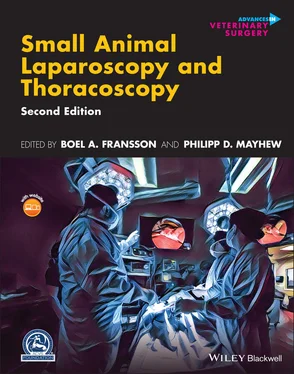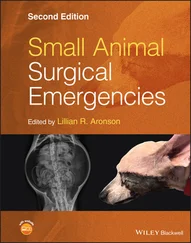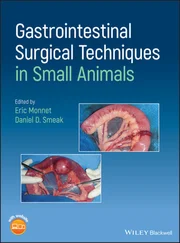Library of Congress Cataloging‐in‐Publication Data
Names: Fransson, Boel A. (Boel Anita), editor. | Mayhew, Philipp D. (Philipp David), editor.
Title: Small animal laparoscopy and thoracoscopy / edited by Boel A. Fransson, Philipp D. Mayhew.
Description: Second edition. | Hoboken, NJ : John Wiley & Sons, Inc, 2022.
Identifiers: LCCN 2021027322 (print) | LCCN 2021027323 (ebook) | ISBN 9781119666851 (hardback) | ISBN 9781119666905 (adobe pdf) | ISBN 9781119666929 (epub)
Subjects: MESH: Laparoscopy–veterinary | Thoracoscopy–veterinary | Pets–surgery | Surgery, Veterinary–methods
Classification: LCC SF914.2 (print) | LCC SF914.2 (ebook) | NLM SF 914.2 | DDC 636.089/705–dc23
LC record available at https://lccn.loc.gov/2021027322LC ebook record available at https://lccn.loc.gov/202102732
Cover Design: Wiley
Cover Image: @ Nikoma Ortiz of En Oh Visuals
Ingrid M. Balsa
Department of Surgical and Radiological Sciences, School of Veterinary Medicine, University of California‐Davis, Davis, CA, USA
Fausto Brandão
Karl Storz GmbH & Co., Lisbon, Portugal
Mauricio Veloso Brun
Small Animal Surgery, Department of Small Animal Clinic,
Santa Maria Federal University (UFSM), Santa Maria, RS, Brazil
Floryne O. Buishand
Department of Clinical Sciences of Companion Animals, Faculty of Veterinary Medicine, Utrecht University, Utrecht, The Netherlands
Nicole J. Buote
Department of Clinical Science, Small Animal Surgery, College of Veterinary Medicine
Cornell University, Ithaca, NY, USA
J. Brad Case
Department of Small Animal Clinical Sciences, College of Veterinary Medicine, University of Florida, Gainesville, FL, USA
Christopher Chamness
Karl Storz GmbH & Co., Santa Barbara, CA, USA
Chiya Chen
Department of Surgery, Veterinary Emergency and Referral Center of Hawaii, Honolulu, HI, USA
William T. N. Culp
Department of Surgical and Radiological Sciences, School of Veterinary Medicine, University of California‐Davis, Davis, CA, USA
Gilles Dupre
European School for Advanced Veterinary Studies, Birkenfeld, Germany
W. Alex Fox‐Alvarez
Department of Small Animal Clinical Sciences, College of Veterinary Medicine, University of Florida, Gainesville, FL, USA
Boel A. Fransson
Department Veterinary Clinical Sciences, Washington State University, Pullman, WA, USA
Lynetta Freeman
Department of Veterinary Clinical Sciences, Purdue University College of Veterinary Medicine, West Lafayette, IN, USA
Erin Gibson
Department of Surgical and Radiological Sciences, School of Veterinary Medicine, University of California‐Davis, Davis, CA, USA
Hiroo Kanai
Hospital Director of Kanai Veterinary Surgery, Himeji, Japan
Nikola Katic
Department of SurgeryVet Chirurgie, Vienna, Austria
Jolle Kirpensteijn
Department of Clinical Sciences of Companion Animals, Faculty of Veterinary Medicine, Utrecht University, Utrecht, The Netherlands
Hills Pet Nutrition, Topeka, KS, USA
Stephane Libermann
Department of Surgery, Centre Hospitalier Veterinaire des Cordeliers, Meaux, France
Felipe J. Lillo Araya
Veterinary Medicine, Viña del Mar Campus, Viña del Mar, Chile
School of Veterinary Medicine, Life Sciences Faculty, Andres Bello University, Santiago, Chile
Kyle W. Martin
Colorado Animal Specialty and Emergency, Boulder, CO, USA
Khursheed Mama
Department of Clinical Sciences, Colorado State University, Fort Collins, CO, USA
Stanley L. Marks
Department of Medicine and Epidemiology, School of Veterinary Medicine, University of California‐Davis, Davis, CA, USA
Sarah Marvel
Southern Arizona Veterinary Specialty and Emergency, Tuscon, AZ, USA
Philipp D. Mayhew
Department of Surgical and Radiological Sciences, School of Veterinary Medicine, University of California‐Davis, Davis, CA, USA
Eric Monnet
Department of Clinical Sciences, Colorado State University, Fort Collins, CO, USA
Sebastiaan A. van Nimwegen
Department of Clinical Sciences of Companion Animals, Faculty of Veterinary Medicine, Utrecht University, Utrecht, The Netherlands
Michelle L. Oblak
Department of Clinical Studies, Ontario Veterinary College, University of Guelph, Guelph, ON, Canada
Tina Owen
Department of Veterinary Clinical Sciences, College of Veterinary Medicine, Washington State University, Pullman, WA, USA
Carrie Palm
Department of Medicine and Epidemiology, School of Veterinary Medicine, University of California‐Davis, Davis, CA, USA
Peter J. Pascoe
Department of Surgical and Radiological Sciences, School of Veterinary Medicine, University of California‐Davis, Davis, CA, USA
Rachel E. Pollard
Department of Surgical and Radiological Sciences, School of Veterinary Medicine, University of California‐Davis, Davis, CA, USA
Claude A. Ragle
Department of Veterinary Clinical Sciences, Washington State University, Pullman, WA, USA
Penny J. Regier
College of Veterinary Medicine, University of Florida, Gainsville, FL, USA
Marlis L. de Rezende
Department of Clinical Sciences, Colorado State University, Fort Collins, CO, USA
Jeffrey J. Runge
Department of Surgery, Guardian Veterinary Specialists, Brewster, NY, USA
Valery F. Scharf
Department of Clinical Sciences, College of Veterinary Medicine, North Carolina State University, Raleigh, NC, USA
Jacqui Scott
College of Veterinary Medicine, University of Illinois, Urbana, IL, USA
Stephanie L. Shaver
Midwestern University College of Veterinary Medicine, Glendale, AZ, USA
Ameet Singh
Department of Clinical Studies, Ontario Veterinary College, University of Guelph, Guelph, ON, Canada
Michele A. Steffey
Department of Surgical and Radiological Sciences, University of California‐Davis, Davis, CA, USA
Elizabeth A. Swanson
Department of Clinical Sciences, College of Veterinary Medicine, Mississippi State University, Mississippi State, MS, USA
Chris Thomson
Veterinary Specialty Hospital – North County, Ethos Veterinary Health, San Marcos, CA, USA
Bart Van Goethem
Faculty of Veterinary Medicine, Ghent University, Ghent, Belgium

The last century has seen an evolution from major invasive surgery to minimally invasive therapies, which have provided great patient benefit with reduced morbidity.
As the practice of minimally invasive surgery has grown, the field has seen the development of newer advanced endoscopes, laparoscopes, laparoscopic instruments, light sources, insufflators, energy devices, and advanced minimally invasive techniques. Unfortunately, most of these advances have been designed for the adult human. Pediatric human patients and small animal patients have had the same struggle – limited information and technology available for this subset of patients. Small patients need smaller insufflators, smaller scopes, smaller instruments, and modified techniques for smaller spaces. Over the past several years, however, pediatric surgeons and small animal veterinarian surgeons have been working together to bring about the advancement of minimally invasive surgery in these smaller populations.
Читать дальше













